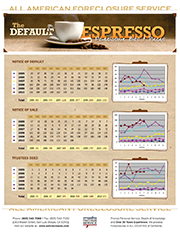You are here
Home ›Frequently Asked Questions
What do I do to start a foreclosure?
You will need to complete our information sheet called "Declaration of Default And Demand For Sale." This form is on our website to be completed digitally or the form can be downloaded, completed by hand and faxed or emailed to us. We will use this information to prepare a Notice of Default for recording which begins the foreclosure process. We will also need a copy of your Deed of Trust and Promissory Note plus any Deed of Trust Assignments, if any. Please call our office for any questions you may have and assistance to complete the form.
When does the foreclosure "start"?
The "foreclosure process" begins with the recording of the Notice of Default. This date starts the 3-month reinstatement period. After this reinstatement period expires All American Foreclosure Service can set a Trustee Sale date no sooner than 21 days later. It is actually about 1 month to allow for posting and publishing procedures. Please check out our Foreclosure Process/Timeline page for more information.
How much does it cost? Are Trustee Fees regulated by statute?
A maximum fee of 1% of the principal amount due on the loan (plus costs) is allowed by statute. However, our fees are negotiable. Please contact us for a quote. We typically require a deposit of 1/3 of the amount on recording the Notice of Default, 1/3 on recording the Notice of Trustee Sale and the final 1/3 on conducting the Trustee Sale. In addition, there are costs incurred of title, mailing, posting the property and publication of notices. These fees vary and are typically between $500 - $1,500, depending on the amount of the note and required mailings. These fees are all chargeable to the borrower. If they reinstate the loan or payoff the loan our fees are included so you are reimbursed.
How long does a foreclosure take?
3 months plus 21 days. Please check out our Foreclosure Process/Timeline page for more information.
What is the "Reinstatement Period"?
The 3 month period after the recording of the Notice of Default. This acts as a grace period, during which the Trustor/Borrower may cure the default by belated performance, if the default is curable. Please check out our Foreclosure Process Timeline page for more information.
What we do during the "Reinstatement Period"?
All American Foreclosure Service will review and forward a copy of the Trustee Sale Guaranty we order from the Title Company, to see who has a recorded interest in the property as owner or as lien holder; check for bankruptcy and ensure proper notice to the Trustor and subsequent owners or junior lien holders. Within 10 days we are required to mail a copy of the Notice of Default to the Trustor and those who have recorded a Request for Special Notice and within 30 days we send a copy of the Notice of Default to any junior lien holders and other parties. Upon expiration of the 3 month reinstatement period, we proceed to set a Trustee Sale.
When can the Trustee Sale take place?
No sooner than 21 days after the reinstatement period ends. Please check out our Foreclosure Process Timeline page for more information.
How do you decide what the “Opening Bid” is at the Trustee Sale?
Generally the opening bid is the amount of the principal, interest, late charges and any other advances made by the lender, including our trustee fees and costs. A lender can opt to reduce their opening bid as it may have some advantages. All strategies in this regard should be planned with the advice of your tax preparer and legal counsel.
What happens at the sale?
We announce the opening bid and ask the bidders to qualify by identifying themselves and showing the Auctioneer their cash and/or cashier’s checks in an amount sufficient to bid. All American Foreclosure Service conducts the sale and the successful bid is the highest bid over the opening bid. If there are other bidders, the highest bidder gains ownership of the property. We then accept money, obtain personal information and give the successful bidder a receipt. The Trustee’s Deed Upon Sale is prepared and delivered to them by the Trustee within a few days of the sale. The lender receives their money and an accounting as well.
What if there are no bidders at the sale?
The property is then returned to the beneficiary. The beneficiary or lender now owns the property and they will receive a Trustee’s Deed within a few days. Their next step would be to make any preparations for taking possession of the property and plans for its disposition or liquidation.
What if my loan is a 2nd Deed of Trust and sometime during this process the 1st Deed of Trust records a Notice of Default?
The process is the same for that Notice of Default. The borrower, or current owner has 3 months plus 21 days to reinstate or payoff the loan. After discussion with legal or tax counsel, it is usually prudent to bring this senior loan current. This advance to a senior can be included in your payoff amount. While you should make attempts to contact the lender, it requires time and patience. We suggest contacting the lender after obtaining a Loan Number, to obtain information or amounts that may be required to bring the loan current (out of default) or to pay if off.
If someone is in the property after I become owner how do I get them out?
You should consult an attorney; however you can ask them, offer them money or sue them for "Unlawful Detainer", an eviction action. Your legal counsel can advise as to cost and time frames.
What if the Borrower (Trustor) calls us to pay off or bring the loan current?
You should direct all of their calls to our office for the exact amount of payoff or reinstatement. We forward this payoff to you for your review and approval. You should not accept any money from the Trustor once the foreclosure is started. In accepting money directly, you run the risk of invalidating the foreclosure and you may have to start the process over by recording a new Notice of Default and waiting out the three month reinstatement period.
What if the Borrower (Trustor) offers to make a partial payment?
Accepting a partial payment can jeopardize the validity of the foreclosure. You can accept a partial payment and rescind the foreclosure; however, you would need to record a new Notice of Default if they remain in default. You can accept money with a forbearance agreement. There are many ramifications of a forbearance agreement; the process should be guided by legal counsel.
What if the Borrower (Trustor) wants to give me the property back in lieu of paying the loan?
That may be considered a "Deed in Lieu" and can be a solution where the Borrower transfers ownership of the property to you avoiding a foreclosure. Use extreme caution in this process; you may be accepting the property subject to encumbrances, liens or judgments. Legal counsel can advise and guide you through this process.
How do I find out if property taxes are paid as well as fire insurance? And should I pay those?
A quick telephone call to the Tax Collector’s office can tell you if taxes are current. To find out about insurances may take investigating if you are not listed as an additional insured on an existing policy. Possibly you are receiving notices from the insurance company and have contact information; maybe you can ask the owner of the property; or if you suspect there is no insurance it might be wise to place your own and have us make note of it as an advance to protect your interest.
Generally, we would recommend payment. Advances by the lender to pay taxes and insurance are allowable and chargeable to the borrower.
Starting a foreclosure is as easy as
- Click on the "Get Started Now" button below.
- Complete the secure online form, or download a printable version.
- Submit the form securely via the website, e-mail, fax, or mail it to us.

When can the Trustee Sale take place?
No sooner than 21 days after the reinstatement period ends. Please check out our Foreclosure Process Timeline page for more information.

2009 To 2014 Foreclosure Statistics for San Luis Obispo County, California
This document details the number of Notice of Defaults, Notice of Sales, and Trustee's Deeds filed in San Luis Obispo County, CA from January 2009 through 2014. For review of data prior to 2009 please contact our office.

